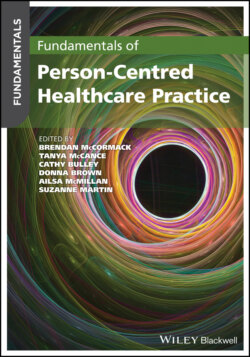Читать книгу Fundamentals of Person-Centred Healthcare Practice - Группа авторов - Страница 28
Self and selfhood
ОглавлениеIn thinking about how we connect with personhood, Sabat (2002) suggests that personhood is connected with different understandings of ‘self’. Rejecting the idea of the ‘loss of self’ that is dominant in dementia discourse and that implies not just a flattening of personhood but its loss, with the consequence of being labelled as a ‘non‐person’, Sabat (2002, p. 27) argues that we have three forms of self – Self 1, Self 2 and Self 3.
Self 1 is ‘the self of personal identity’ evidenced through our use of personal pronouns: ‘I’, ‘me’, ‘mine’, ‘myself’, ‘ours’ (meaning mine and yours). This self relates to our individual and unique view of the world. It expresses how we relate to our being in the world and the words we use to describe this being. It is autobiographical in nature and forms the narrative of our lives. Through Self 1, we tell the stories of our lives, and often how we tell those stories gives some indication of what is important to us. Sabat argues that a loss of words and language (such as happens with people living with dementia) does not mean a loss of self; rather, this Self 1 remains intact but the challenge is how we can enable such persons to voice their stories. Identical diagnosis and apparent severity of dementia, or other conditions, does not mean we can understand all persons in the same way.
Self 2 comprises our physical, mental and emotional attributes past and present – eye colour, height, weight, beliefs, religion, happiness, love, sadness, achievements, hobbies and so forth are all examples of Self 2. Again, these remain relatively intact with the threat of disease and illness. However, Self 2 becomes a problem when others focus on deficits and decline rather than abilities and potentials. Whilst the symptoms of a disease might impact on our physical, mental or emotional attributes, the attributes themselves do not change – what changes is how others engage with this aspect of our self.
Self 3 comprises the different social personas that we construct in different situations in which we live our lives. In different situations and contexts, a person may display very different behaviours – a highly dedicated and professional healthcare person by day and a hard party‐goer by night; a focused, targeted and ‘hard‐nosed’ manager versus a loving, sensitive and intimate partner.
Sabat argues that Self 3, the social persona, is most vulnerable when threatened by disease and illness, as it is dependent on a connection with at least one other person in our social world. Whilst this threat is obvious in a person living with dementia, we can also see the potential for loss of Self 3 in all kinds of illness situations where the autobiographical self is not considered; that is, we are concerned with treatment and cure and not with the social construction of that illness and how it threatens our personhood – something central to the argument made for a person‐centred approach to practice in many of the chapters in this book. Self 3 fits most closely with Kitwood’s ideas on personhood as social status bestowed by others (Dewing 2018).
Of course, these constructions of self can also be challenged and debated as there are a variety of ways in which Self 1–3 can change and/or be altered, and indeed the question needs to be asked, ‘are we limited to three kinds of self?’. However, Sabat's ideas demonstrate how interiority (Leibing 2008) links with Smith's (2003) ideas of culture as an important basis for understanding how our behaviours can impact on the personhood of others. Paying attention to Self 1 and 2 is therefore critical for the protection of personhood in situations where a person is vulnerable and in need of care. Sabat's expression of self resonates with Merleau‐Ponty's argument about the primacy of a ‘perceiving body’ in the world (Dewing 2012). Merleau‐Ponty argues against any idea of a mind–body split or that we are passive recipients of our history. Instead, he suggests that our knowing is always subjective as we carry through the movement in our bodies, our prehistories that we take up, inherit and transform through our being in the world. Therefore, Self 1 is ever‐present, even in the absence of rational thought.
So we could summarise by suggesting that ‘persons are persons because of their personhood’ and that this is what distinguishes human persons from non‐human persons. We are more than our body parts held together by connective tissue – we are interacting persons, guided by whilst also shaping and reshaping our being in the world through our interior and exterior conditions. Yes, persons are complex!
